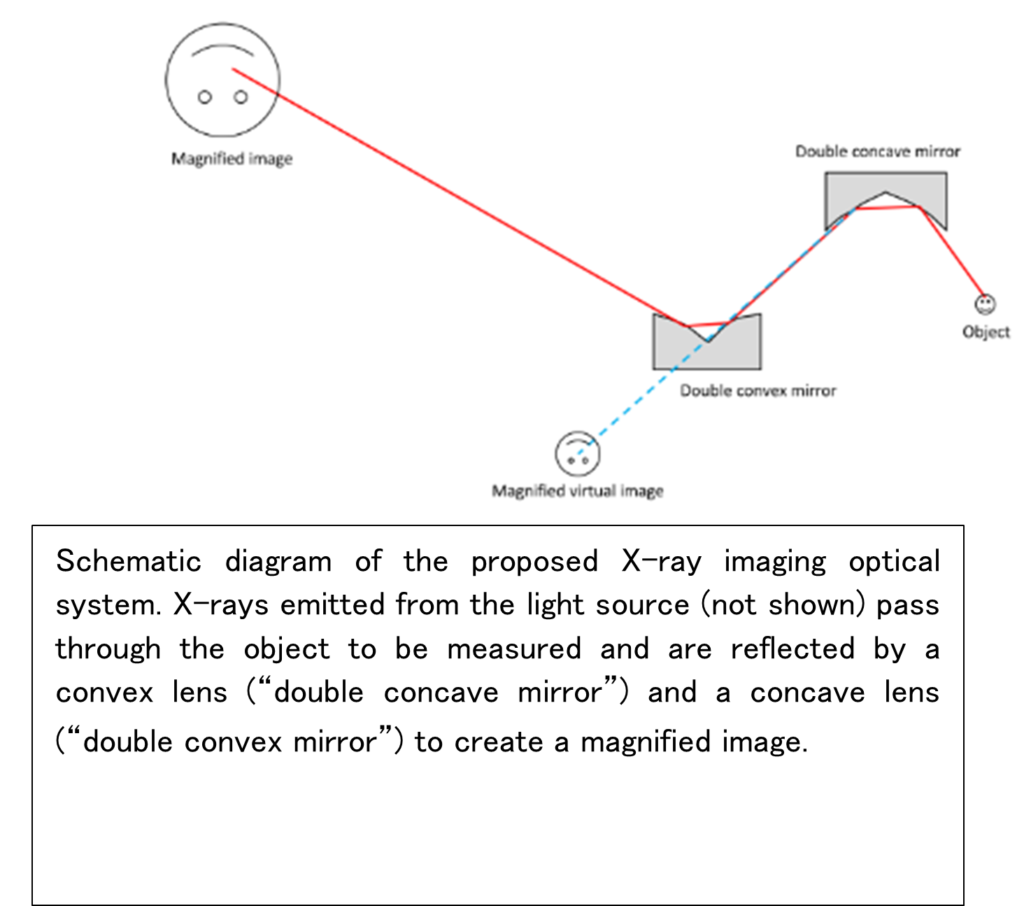Summary
- Proposal for a new X-ray imaging optical system, further advancing KB mirror technology for higher performance and lower cost.
- Developed a “lens” consisting of two mirrors in one piece, which functions to magnify X-ray images at high magnification.
- Even if the lens is installed inaccurately, the optical system absorbs the misalignment and maintains high resolution.
- Because it also absorbs misalignment caused by vibration and heat, this system also reduces the running cost of X-ray observation equipment.
- The university is searching for companies to introduce this system as a new X-ray microscope product.
Background & Technology
X-ray microscopes are imaging devices that have become increasingly necessary in recent years, taking advantage of the high transmissivity of X-rays while overcoming their characteristic difficulty in image formation. The Kirkpatrick-Baez mirror (KB mirror) is known as a typical X-ray grazing incidence optical system; although the KB mirror does not cause chromatic aberration, its coma aberration makes it difficult to use as an imaging optical system. Professor Tomoyuki Matsuyama of Nagoya University’s Graduate School of Engineering has developed a new optical system, the Advanced KB mirror (AKB mirror), which improves on the KB mirror and eliminates coma aberration (see papers 1 and 2). The AKB mirror system consists of four concave mirrors and functions as the objective lens of an X-ray microscope.
Professor Matsuyama has now developed an even newer X-ray imaging optical system (see Paper 3). This optical system consists of a group of mirrors that function as a “concave lens” and a “convex lens” for X-rays. Professor Matsuyama discovered that a structure consisting of two hyperbolic convex mirrors integrated in a V-shape works as a concave lens for X-rays, and that a structure consisting of a hyperbolic concave mirror and an elliptic concave mirror integrated in a V-shape works as a convex lens. The combination of these two elements as shown in the figure below is the imaging optical system proposed here. This optical system is not only free from chromatic aberration, as is the case with KB mirrors, but also free from coma aberration, as is the case with Advanced KB mirrors, making it extremely suitable as an optical system for X-ray microscopes.
 |
The main feature of this optical system is its high robustness and resulting low cost. Typical X-ray optical systems are very sensitive to mirror alignment (position and angle), and deviations at the nanometer and micrometer level affect their resolution. However, this optical system is robust against rotational misalignment in the direction perpendicular to the surface of the paper in the above figure. In fact, simulations of the case with rotational misalignment of several to several tens of micrometers and the correct position show that the point spread function is almost the same. Conventional X-ray optical systems have one mirror each, but this optical system is robust because the two mirrors are integrated to form a lens. This means that not only can the cost be reduced due to the large deviation that can be tolerated in the design and manufacturing stages of the X-ray microscope, but also the running cost can be reduced during the installation and maintenance stages because the microscope is less susceptible to vibration, heat, etc.
Expectation
Prof. Matsuyama is looking for a company to commercialize an X-ray microscope employing this optical system. Please consider introducing this technology as a next-generation business for your company.
We can provide you with information and insights through the following steps, and can discuss how we can assist you in considering and commercializing the introduction of this technology in your company.
- Response to your questions
- Meeting with Prof. Matsuyama to explain the details of the project
- Exchange of information under NDA
- Joint research
- Patent Licensing
Researcher
Prof. Satoshi Matsuyama, Nagoya University Graduate School of Engineering
Patent & Publication
- Patent PCT/JP2021/039424
https://worldwide.espacenet.com/patent/search?q=pn%3DWO2022092060A1 - Paper 1 about Advanced KB mirror
50-nm-resolution full-field X-ray microscope without chromatic aberration using total-reflection imaging mirrors
https://www.nature.com/articles/srep46358 - Paper 2 about application of Advanced KB mirror
Full-field X-ray fluorescence microscope based on total-reflection advanced Kirkpatrick–Baez mirror optics
https://opg.optica.org/oe/fulltext.cfm?uri=oe-27-13-18318&id=414532 - Paper 3 about this technology
Wide field-of-view x-ray imaging optical system using grazing-incidence mirrors
https://opg.optica.org/ao/abstract.cfm?uri=ao-61-35-10465
Project.DA-03329


